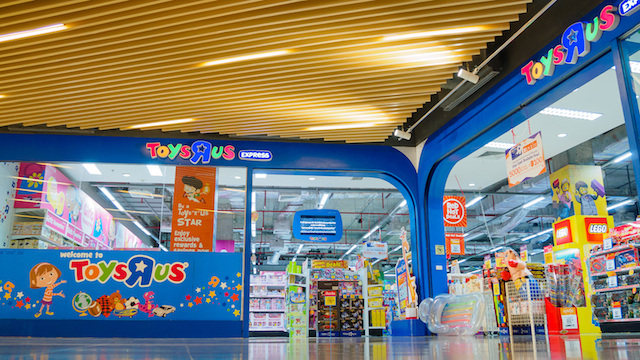Toys R Us has filed for Chapter 11 bankruptcy protection in the US and Canada – but the company stresses its Asian and other international businesses are unaffected.
Toys R Us Asia and its subsidiaries operate 226 stores in Greater China and Southeast Asia – including in Brunei, China, Hong Kong, Malaysia, Singapore, Taiwan and Thailand and licenses an additional 35 stores in the Philippines and Macau. In March, Toys R Us Japan was successfully integrated into the Toys R Us Asia business, adding a further 161 stores to the region.
Andre Javes, president of Toys R Us Asia, reaffirmed the company is continuing as usual.
“We are a financially robust and self-funding retail operation, which continues to significantly grow and invest in this region. Every year we are opening new stores in all our markets and particularly in China where we now operate over 135 stores and will be opening another 22 in the coming weeks.
The embattled toy retailer operates about 1600 stores globally, all of which will continue to trade through the restructuring process under bankruptcy protection.
“Our Toys R Us and Babies R Us stores and e-commerce sites around the world are open for business and are continuing to offer customers great service and a curated assortment of merchandise in the toy and baby categories,” the company said in its statement.
Chapter 11 protection appeared likely earlier this month, when the company called in restructuring advisors for advice on how to reorganise its mounting debt burden.
“We are confident that we are taking the right steps to ensure that the iconic Toys R Us and Babies R Us brands live on for many generations,” said Dave Brandon, chairman and CEO. “Our customers around the world can continue to count on an outstanding shopping experience and excellent service whenever, wherever and however they choose to shop with us.”
“Turbulent chapter” comes to an end
Neil Saunders, MD of GlobalData Retail, says entering bankruptcy protection does not
necessarily mean it is game over for the company, but it does bring to a close a turbulent chapter in its history.
“A combination of high debt and severe structural changes in the industry created a toxic mix against which Toys R Us had little choice but to restructure and try to put itself on a firmer footing,” Saunders said.
“The past decade has seen a dramatic change in the domestic toy market with new channels, increased competition, and new technology all having a deleterious impact on the sector and traditional toy stores. Unfortunately, Toys R Us has not responded effectively to these challenges and, as a result, has found itself with both a weak balance sheet and falling sales.
“The channel shift is not exceptional to toys, but it has fundamentally changed the economics of toy store retailing. We estimate that last year some 13.7 per cent of all toy sales were made online; that’s up from 6.5 per cent five years ago. This is one of the reasons why sales of toys at many specialists, including Toys R Us, have been weak when measured on a comparable store basis.”
Saunders says the rise of online has undermined the economics of toy shops.
“For larger chains, like Toys R Us, some of the shift can be offset by using stores as a place of collection and, indeed, as a place to fulfill from. However, the failure of the firm to invest properly in its online proposition mean that these initiatives were only ever going to mitigate rather than solve the online shift.
“The rise of online has also seen the emergence of new, powerful players in the toys market, including Amazon. However, competition has also come from generalists like Walmart where the offer of low prices and convenience is alluring for many parents, hard pressed for both time and money. The impact has been two-fold. First, the extra competition has meant that the price of toys – many of which are branded and therefore easily comparable between stores – has risen little over the past five or so years, exerting significant pressure on margins. Second, specialists have gradually seen their share of the toy market eroded.”
The Apple effect
Saunders says that if competition from within the toy sector has exerted a toll on traditional retailers, the impact of competition from outside the sector has been equally, if not more, punishing.
“Retailers like Apple, and its app store, are taking more of kids’ spend than ever before. Children’s interest in electronics is nothing new; as far back as the early 1980s kids were buying up Nintendo’s Game & Watch devices, featuring Donkey Kong and other exciting platform style games. However, with their relatively low prices (a Game & Watch cost $48 in today’s money) such products were often complementary to spending on traditional toys and, indeed, would often be sold by toy stores themselves.
“Today it’s different. For many children, electronics have become a replacement or a substitute for traditional toys. Our data shows that some 67 per cent of young teens personally own at least one tablet or smartphone device and that among the cohort 59 per cent say spending on such devices is a priority. With even the most basic of products having a high price tag, there is often little left over – either from the child’s budget or the gifting budget of parents and family – to spend on other toys.
“All of these shifts have hit the sector hard, and as iconic as it was, and arguably still is, Toys R Us is not immune. Indeed, the combination of punishingly high debts and challenges on the sales line arguably left the company in an incredibly tough spot.”
Looking ahead, lowering debt and streamlining the business should help to create a more sustainable operation, says Saunders. However, even if the debt issues are solved Toys R Us still faces massive structural challenges against which it must battle.
“The jury is out as to whether it can adapt enough to survive. The decisions it takes now, and the vision it sets out for the future will determine whether or not the Toys R Us story has a happy ending.”






